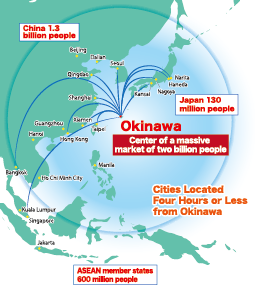Home > Highlighting JAPAN > Highlighting Japan February 2017 > New Pioneers of Local Development
Highlighting JAPAN


Gateway Okinawa
Okinawa Prefecture is re-establishing itself as a major international logistics hub.
Okinawa Prefecture, which is the southernmost of all the prefectures in Japan and consists of 160 large and small islands, was an independent state known as the Ryukyu Kingdom from the fifteenth to nineteenth century. The Ryukyu Kingdom carried out entrepôt trade with neighboring countries, such as the Japanese mainland, China, Korea and other Southeast Asian countries. The kingdom played a central role as a self-proclaimed Bankoku shinryo (Bridge between nations), and thrived.
With that history, Okinawa Prefecture has been developing as an international logistics hub in recent years. Naha Airport, which is located on the main island of Okinawa, the largest island, plays a central role. Naha Airport’s international freight volume was about 1,800 tons in 2008, but by 2015 was 100 times that amount, at 180,000 tons. This is the fourth largest international freight volume in Japan, after Narita Airport, Kansai International Airport and Tokyo International Airport.
“With economic growth rising in East Asia, logistics is becoming very animated in this region,” says Satoru Motonaga of the Okinawa Prefectural Government’s Asian Economic Strategy Division. “Okinawa enjoys the significant geographical advantage of its location in the center of East Asia. You can travel to major East Asian cities, such as Tokyo, Seoul, Taipei, Hong Kong and Shanghai, within four hours.”
A significant factor that triggered the sharp increase in international cargo volume at Naha Airport was that All Nippon Airways (ANA) constructed cargo service networks connecting Japanese and other major Asian cities from the airport in Okinawa in 2009. ANA handles the unloading and loading of cargo and customs clearance operations at the Naha Airport Cargo Terminal built at Naha Airport. ANA collects cargo from other parts of the country at Okinawa using cargo planes and passenger planes and transports the cargo to major Asian cities, such as Shanghai, Hong Kong, Bangkok and Singapore. In addition, cargo imported from Asia is collected at Okinawa and transported to various places in Japan. Because Naha Airport, one of Japan’s few airports running for 24 hours, can handle uninterrupted customs clearance procedures, the lead time can be significantly shortened. For example, cargo leaving Tokyo or Osaka at around 9 p.m arrives at Naha Airport at around midnight. The cargo departs from Okinawa at around 5 a.m after four-hour unloading, loading and customs clearance procedures, and is transported to major cities in Asia the next morning. In short, parcels can be carried to major cities in Asia from Japan in just one day.
“Shortening the lead time expands the possibility of exports of Japanese products,” says Motonaga. “Now we can provide people living in major Asian cities with fresher Japanese vegetables, fruit and marine products. Business opportunities are expanding.”
For instance, the amount of strawberries exported through Naha Airport significantly increased from about one ton in FY2013 to 16 tons in FY2014. Many prefectures are also active in exporting agricultural and marine products through Naha Airport. Aomori Prefecture has established a distribution service for delivery of fresh foods to Asia in cooperation with Yamato Transport Co. by making use of Okinawa’s international logistics hub. For example, fresh fish and fresh scallops exported from Aomori are highly regarded by a Japanese luxury restaurant chain in Hong Kong for their freshness and good taste.
To promote the use of the international logistics hub, Okinawa Prefecture also implements measures such as providing support for container charges. As a result, in addition to specialty products of other prefectures, Okinawa’s export of local processed food items, such as tofu and kamaboko (white fish loaves), vegetables, such as purple yams and tomatoes, and beef and tuna are increasing.
In addition, the Okinawa Prefectural Government hosts the Great Okinawa Trade Fair, one of Japan’s largest business matching events, as an international food trade negotiation fair, to expand overseas markets for local specialties produced in many regions of Japan. At the fourth trade fair that was held in November 2016, about 260 suppliers of agricultural, forestry and marine products and processed food and 200 buyers from fifteen countries and regions, got together and had active trade negotiations.
An increasing number of companies outside the agricultural and fisheries industries are also using Okinawa’s international logistics hub. For example, Toshiba Corporation, a leading electrical appliance manufacturer, consolidated its stock bases of maintenance parts and consumables scattered around East Asia at the international logistics center adjacent to Naha Airport. Toshiba seeks to reduce the lead time and costs through centralized management by receiving orders from East Asia in Okinawa as well as delivering products from there.
Okinawa will continue to enhance its functions as an international logistics hub. At Naha Airport, the second runway is now under construction, scheduled for completion in 2020. In addition, the Integrated Distribution Center will be completed in 2018 as a maritime logistics base at the port of Naha, adjacent to Naha Airport. At the center, it will be possible to sort and transport cargo from home and abroad, and process the products. This is expected to achieve the connection between maritime and aerial transportation.
“The East Asian economy is expected to grow further,” says Motonaga. “Okinawa aims to utilize the vitality of the East Asian economy and develop together with many other countries by playing the role of a regional hub, connecting the major East Asian cities.”
© 2009 Cabinet Office, Government of Japan







